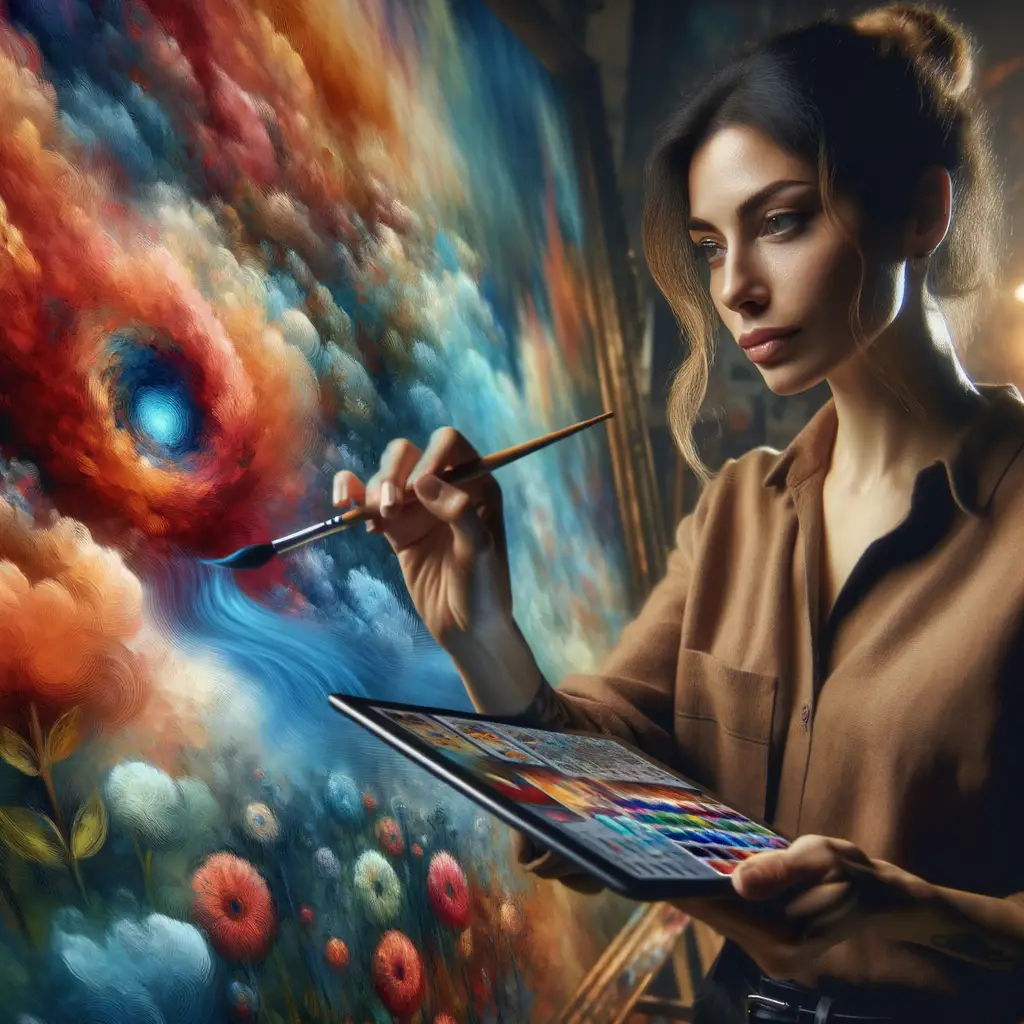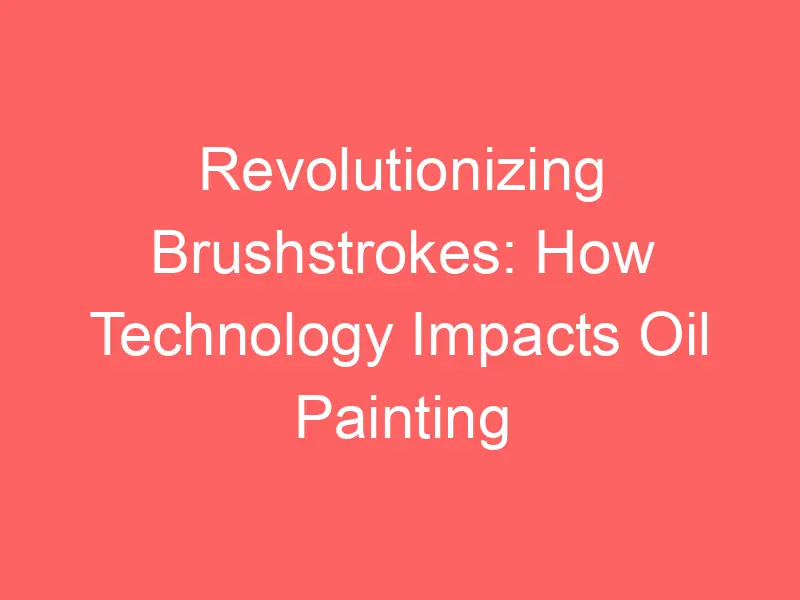
Introduction to Technology in Oil Painting
Art has been a part of human culture for thousands of years. It has evolved over time, adapting to the changes in society and technology. One form of art that has seen significant evolution is oil painting. Let’s explore how technology has influenced oil painting and the art world as a whole.
- Overview of the evolution of oil painting techniques
- Introduction to the influence of technology on art
Oil painting, a form of art that uses oil-based pigments, has been around since the 7th century. However, it wasn’t until the 15th century that it became widely used in Europe. The traditional technique involved applying layers of paint to a canvas, allowing each layer to dry before adding the next. This method allowed artists to create depth and texture in their work.
Over the years, artists started experimenting with new techniques and materials. They began using different types of oils, like linseed and walnut, to achieve different effects. They also started using different tools, like palette knives and sponges, to apply the paint. These innovations led to the development of new styles and genres of oil painting, such as impressionism and abstract expressionism.
Today, technology has further revolutionized oil painting. Artists now use digital tools and software to create oil paintings. These tools allow them to experiment with colors, textures, and techniques in ways that were not possible with traditional methods. Digital painting has opened up a whole new world of possibilities for artists.
Technology has had a profound impact on art. It has not only changed the way artists create art but also the way we view and interact with it. In the past, art was primarily viewed in galleries and museums. Today, thanks to technology, art is accessible to everyone, everywhere. We can view and purchase art online, and even create our own using digital tools.
Technology has also expanded the possibilities for creativity in art. With digital tools, artists can experiment with different styles and techniques without the limitations of traditional materials. They can also create art that interacts with the viewer, such as virtual reality art and interactive installations.
Despite the many changes brought about by technology, the essence of art remains the same. It is still a form of expression, a way for artists to communicate their thoughts and feelings. Technology has simply provided new tools and platforms for this expression.
Modern Oil Painting Techniques
As we delve into the world of modern oil painting techniques, it’s important to understand the differences between traditional and digital methods. Both have their unique attributes and impacts on the art world.
Traditional vs. Digital Oil Painting
Let’s take a closer look at these two distinct forms of oil painting.
- Comparison of traditional and digital oil painting techniques
- Impact of technology on traditional painting
Traditional oil painting involves the use of brushes and oil paints on a canvas. It’s a tactile and sensory experience, where the artist has direct contact with the materials. Every brushstroke is unique, and the texture of the paint can be manipulated in countless ways.
Digital oil painting, on the other hand, is a newer form of art that uses digital tools like graphic tablets and software. Artists can simulate the look and feel of oil paint, but with the added benefits of undo buttons, layering without waiting for drying, and no need for physical storage space. However, it lacks the tactile experience of traditional painting.
Technology has significantly impacted traditional painting. Digital tools have opened up new possibilities for creativity and experimentation. They have also made art more accessible, as anyone with a computer and the right software can start painting digitally.
However, this doesn’t mean that traditional oil painting is becoming obsolete. Many artists still prefer the physicality and unique characteristics of traditional methods. In fact, some artists use both traditional and digital techniques in their work, creating a hybrid form of art.
In conclusion, both traditional and digital oil painting techniques have their strengths and weaknesses. It’s up to each artist to choose the method that best suits their style and vision. As technology continues to evolve, we can expect to see even more exciting developments in the world of oil painting.
Innovation in Oil Painting Techniques
The world of art is constantly evolving, and oil painting is no exception. Technological advancements have led to significant changes in how artists approach this traditional medium. Let’s explore these innovations and see how they’re shaping the future of oil painting.
- Technological Advancements in Oil Painting
- Case Studies of Artists Using Modern Techniques
Technology has introduced new tools and materials that have revolutionized oil painting. For instance, the advent of acrylic paints has provided artists with a faster-drying and more versatile alternative to traditional oil paints.
Moreover, digital technology has also made a significant impact. Artists can now use software like Photoshop and Procreate to mimic the effects of oil painting, without the need for physical materials. This not only makes the art form more accessible but also allows for greater experimentation and creativity.
Many contemporary artists are embracing these new technologies and incorporating them into their work. For example, British artist David Hockney has been known to use iPads and digital brushes to create stunning pieces that mimic the look and feel of oil paintings.
Similarly, American artist Alyssa Monks combines traditional oil painting techniques with digital manipulation. She often starts her work digitally, experimenting with composition and color before transferring her designs onto canvas.
These examples showcase the potential of technology in oil painting. As we continue to innovate, who knows what exciting developments the future might bring?
Oil Painting in the Digital Age
As we step into the digital age, the world of oil painting is not left behind. The fusion of technology and art has brought about a revolution, transforming the traditional canvas and brush techniques into a blend of pixels and software. Let’s delve into this fascinating intersection of technology and art.
Technology and Art Fusion
Technology has seamlessly blended with art, creating a new realm of possibilities for oil painting. This fusion has not only expanded the boundaries of creativity but also made art more accessible to everyone.
- Examples of technology and art fusion in oil painting:
- Key takeaways from the fusion of technology and art:
One of the most notable examples of this fusion is the use of digital painting software like Adobe Photoshop and Corel Painter. These programs allow artists to mimic the texture and blending of oil paints, creating stunning digital oil paintings. Another example is the use of 3D printing technology to reproduce oil paintings, allowing art enthusiasts to own a tactile replica of their favorite artworks. Learn more about digital painting here.
The fusion of technology and art in oil painting has democratized art, making it accessible to everyone regardless of their skill level or resources. It has also opened up new avenues for creativity, allowing artists to experiment with different styles and techniques that were not possible with traditional oil painting. Moreover, technology has made art more interactive, engaging, and personal, enhancing the overall art experience. Read more about the fusion of art and technology here.
In conclusion, the digital age has revolutionized oil painting, bringing about a fusion of technology and art that has expanded the boundaries of creativity and made art more accessible to everyone. As we continue to embrace technology, we can expect to see more exciting developments in the world of oil painting.
Impact of Technology on Traditional Painting
Technology has had a profound impact on the world of traditional painting. It has not only changed the way artists create their masterpieces, but also how we view and appreciate art. Let’s delve into the details.
- How technology has changed the landscape of traditional painting
- Case studies of traditional artists adapting to technology
With the advent of technology, artists are no longer confined to their studios. They can now create art anywhere, anytime, thanks to digital painting tools and software. These technological advancements have also opened up new possibilities for creativity. For instance, artists can now experiment with a variety of textures, colors, and techniques that were not possible with traditional painting methods.
Moreover, technology has made art more accessible. Artists can now share their work with a global audience through online platforms and social media. This has not only increased the visibility of artists but also made art more accessible to the general public.
Many traditional artists have successfully adapted to the digital age. For instance, David Hockney, a renowned British painter, has embraced technology and uses it as a tool to enhance his traditional painting techniques. He uses iPads to create digital paintings, which he then prints on canvas. This fusion of traditional and digital art has allowed him to experiment with new styles and techniques.
Another example is Yoko Ono, a Japanese multimedia artist, who has used technology to create interactive art installations. Her work encourages viewers to participate and interact with the art, creating a unique and immersive experience.
In conclusion, technology has revolutionized the world of traditional painting, opening up new avenues for creativity and innovation. As artists continue to adapt and embrace these changes, we can look forward to a future where art and technology coexist in harmony.
Conclusion: The Future of Oil Painting
As we look towards the future, it’s clear that the art of oil painting is not only surviving but thriving, thanks to the advent of technology. The digital age has opened up new avenues for creativity and expression, transforming traditional oil painting techniques into something more dynamic and versatile.
- Future trends in digital oil painting
- Final thoughts on the impact of technology on oil painting
One of the most exciting trends in digital oil painting is the rise of virtual reality (VR) and augmented reality (AR) technologies. Artists are now able to create immersive, three-dimensional paintings that viewers can interact with. This not only changes the way we create art but also how we experience it. According to a Wikipedia article, digital painting is expected to continue to evolve as technology advances, offering even more possibilities for artists and art enthusiasts alike.
Technology has undeniably had a significant impact on oil painting. It has expanded the boundaries of what is possible, allowing artists to experiment with new techniques and mediums. While some may argue that this takes away from the traditional art form, it’s important to remember that art is a reflection of the times. As our world becomes increasingly digital, it’s only natural that our art does too.
In conclusion, the future of oil painting is bright and full of potential. With the integration of technology, artists are able to push the boundaries of creativity and expression. As we move forward, it will be exciting to see how these trends continue to evolve and shape the world of oil painting.



















